ORDER
Falconiform.es
FAMILY
Falconidae
GENUS & SPECIES
KEY FEATURES
• The largest and most powerful falcon
• Its plumage ranges from almost pure white, through shades of brown and gray, to nearly black
• Breeds farther north than any other bird of prey, nesting on coasts and tundra in the High Arctic and sub-Arctic
• A superb hunter, it snatches prey in midair or from the ground
WHERE IN THE WORLD?
Found in a broad band across northern Eurasia and North America, including coastal areas of Greenland and Iceland; moves south in winter, sometimes reaching northwestern and central Europe
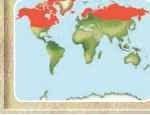
Lifecycle
Power and grace combine effectively in the gyrfalcon, one of the top predators in the snowy wastes of the far north. The falcon’s stealth ensures that it usually goes unseen.
HABITAT
Seemingly immune to cold conditions, the gyrfalcon lives in the belt of treeless tundra that lies between the Arctic Ocean and the vast coniferous forests to the south. It also haunts rocky coasts and small
inshore islands, where seabird colonies provide plenty of food supply. Farther south, it frequents moors and mountains.
Out in the open The gyrfalcon is at home in rocky landscapes.

A nesting gyrfalcon attacks anything that dares approach its eggs or chicks, including golden eagles, red foxes and even wolverines.
The white, dark and intermediate morphs (color varieties) of the gyrfalcon often interbreed, producing mixed-color broods.
The Romans first trained gyrfalcons for hunting.
BEHAVIOR
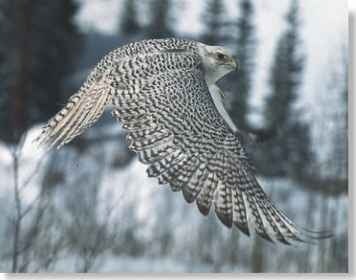
A super sense
Excellent twilight vision enables the gyrfalcon to hunt in the winter gloom.
In flight, the gyrfalcon generates great power and speed with its shallow wingbeats, which are slower and more measured than those of smaller falcons. A large female can take off with a kill weighing almost 4.5 lbs.
The gyrfalcon is naturally scarce and normally occurs singly or in pairs. Groups of young birds, sometimes seen in autumn, are likely to be brothers and sisters, which tend to remain together for several months after becoming independent of their parents.
BREEDING
The spectacular aerobatic skills of the gyrfalcon can be seen at the onset of the breeding season, when the male displays to attract a mate to his territory. His performance includes sideways rolls and vertical loops as he rises and falls in the sky. He flies back and forth close to the nest site, wailing loudly while carrying prey in his clenched feet. When a female arrives, the two birds fly in formation. The female rolls over and presents her talons as he dives past.
The gyrfalcon does not build its own nest. Instead, it uses a depression on a rocky ledge or takes over a raven’s abandoned stick nest. An average clutch consists of 3-4 eggs, but the female may lay up to seven eggs if prey is abundant, or none at all in famine years. The female takes care of most of the incubation, while her mate brings food, which he continues to do after the downy chicks hatch.The female starts hunting for the family when the nestlings are 2-3-weeks old, and they are independent within two months.
Room with a view
A nest is often just a sheltered cliff ledge.
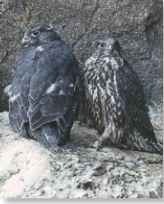
CONSERVATION
The gyrfalcon has escaped pesticide poisoning in its remote homelands — a fate suffered by many falcons living farther south. But growing numbers of its eggs and young are stolen to provide birds for falconry. Some estimates put the gyrfalcon’s world population at less than 5,000 pairs, and it may soon become a threatened species.
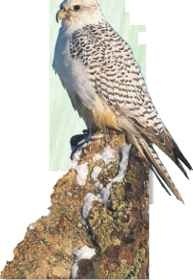
FOOD & HUNTING
The gyrfalcon’s diet consists mostly of ptarmigan. On coasts, it takes gulls, auks, ducks and geese; mammal prey includes ground squirrels, lemmings, voles and hares.
The gyrfalcon attacks most of its prey on or close to the ground, so it seldom performs the high, near-vertical dives with which the peregrine knocks birds out of midair Making less spectacular, but more persistent dives from lower altitudes, the gyrfalcon skims the ground to flush out and kill hidden quarry. If the prey evades the initial assault, the gyrfalcon gives chase until it can finish the hunt with a sudden rise and a swift and deadly dive. Some pre is not eaten at once but stored on a cliff ledge for later, in case bad weather prevents hunting.
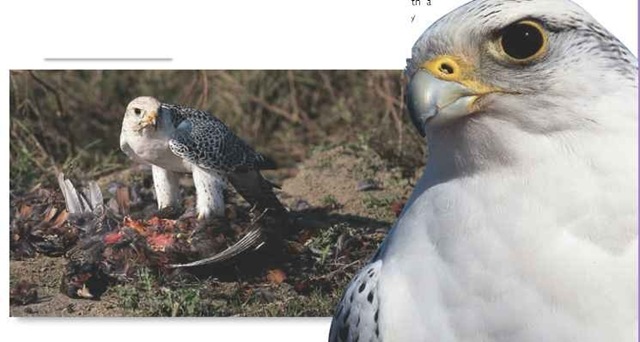
SNOW BUSINESS
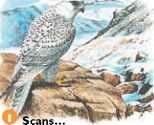
A female white-morph gyrfalcon surveys her snowbound territory from a lofty crag.

2 Startles…
She spots a ptarmigan and makes a silent, low-level approach. The quarry panics into flight.

3 Stoops…
As the ptarmigan zigzags to try and shake off its attacker, the gyrfalcon gains height to launch a dive.
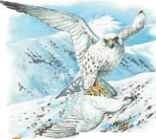
4 Strikes
Feathers fly as the gyrfalcon’s strong talons strike their target with tremendous force.
PROFILE
Gyrfalcon
The gyrfalcon is nearly twice as heavy as the peregrine falcon, which enables it to kill bigger prey and helps it survive the bitter Arctic cold.
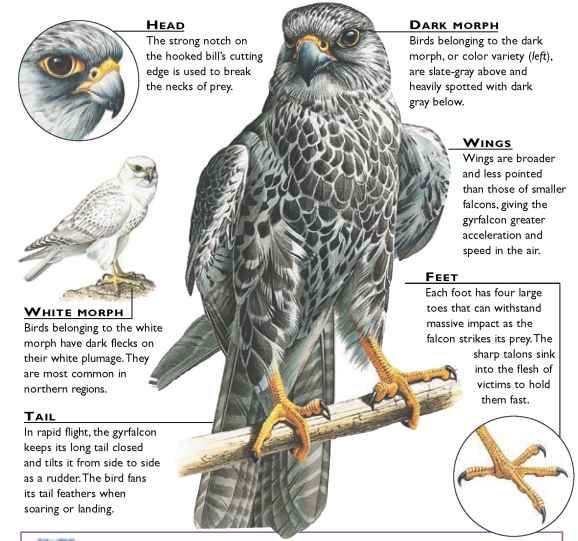
CREATURE COMPARISONS
No bigger than a sparrow, the black-thighed falconet (Microhierax fringillarius) is the world’s smallest bird of prey, weighing a mere I oz. — a little over I % of a female gyrfalcon’s weight. But the two species have much in common: the falconet has sharply clawed feet for catching its prey of insects, lizards and small birds, and a hooked bill for tearing food into pieces, eyesight is keen, and its wings proportionately long. A resident tropical forests in Thailand, Malaysia and Indonesia, the falconet spots perching on a branch, often at the edge of a clearing or beside a river It sometimes hunts in groups of up to ten birds, with the members working together to outmaneuverthe largest victims.
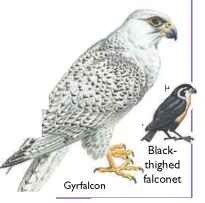
| VITAL | |
| STATISTICS | |
| Weight | Male 2-3 lbs.; female 2.5-4 lbs. |
| Length | 19-24″ |
| Wingspan | 4-4.5′ |
| ‘Sexual Maturity; | 2-3 years :’ |
| Breeding Season | April-July |
| Number of Eggs | Up to 7; usually 3 or 4 |
| Incubation Period | 34-36 days |
| Fledging Period | 46-53 days |
| Typical Diet | Small to medium-sized birds, especially grouse and seabirds; some lemmings and other mammals |
| Lifespan | Up to 13 years |
RELATED SPECIES
• The gyrfalcon is I of 37 species in the genus Falco, or falcons. Its closest relatives are the peregrine falcon, F. peregrinus, which occurs on every continent, and the saker, F. cherrug, which breeds in the open steppes of central Asia.
The falcons are members of the family Falconidae,along with 9 species of falconet and pygmy-falcon, 5 species of forest falcon, 9 species of caracara and the laughing falcon.

